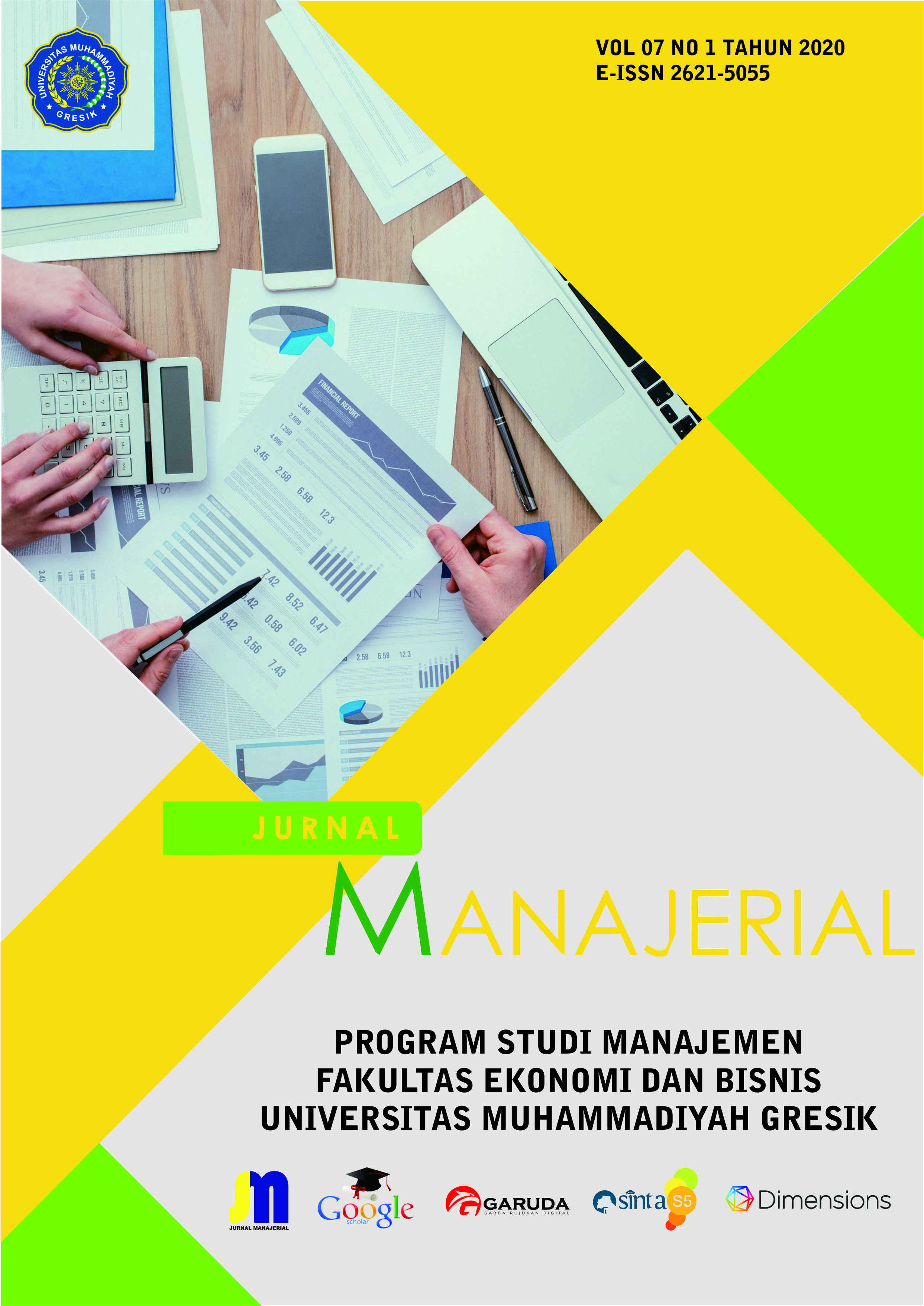Pengaruh Fitur Arsitektur, Fitur Interior Dan Fasilitas Penunjang Terhadap Shopping Value
DOI:
https://doi.org/10.30587/jurnalmanajerial.v7i01.977Keywords:
Architecture, Interior, Features, Facilities, Shopping, valueAbstract
Backgorund - The growing middle class society is growing and the growth of shopping centres has now become a phenomenon in Indonesia. The increase in purchasing power is related to the consumptive pattern which is an indicator of the classification of the middle class in a society. Implicitly this can indicate that the development of shopping centres in Indonesia is influenced by the growth of the middle class in Indonesia. Aim - This study aims to examine the relationship between architectural features, interior features, and supporting facilities on shopping value. Design / methodology / approach - This study uses a non-probability sampling method, namely convenience sampling. This study included 130 respondents. Data collected by conducting surveys. The analysis technique used in this study is multiple linear regression analysis. Finding - The results show that two of the three hypotheses are supported. The hypothesis is the relationship between interior features and shopping value, and the relationship between supporting facilities and shopping value. Research Implication – Managerial implications of the results of this study are to encourage increased comfort associated with architectural features such as the lobby or a comfortable entrance position. This increased comfort is also related to the material used in the architecture. Limitation - This research cannot be separated from the limitations of the study as follows. First, this study uses a non-probability sampling design in which the results of the study cannot be generalized. Secondly, this study only uses one mall.
References
Baker, J. 1982. The Role of the Environment in Marketing Service: The Consumer Perspective. In J. A. Czepiel, C. A. Congram, & J. Shanahan, The Service Challenge: Integrating for Competitive (pp. 79-84). Chicago, Illinois: American Marketing Association.
Bakirtaş, H., İ.Bakirtaş dan M. A. Çetin. 2015. Effects Of Utilitarian And Hedonic Shopping Value And Consumer Satisfaction On Consumer Behavioral Intentions. Ege Academic Review 15(1): 91-98.
Berman, B dan J.R. Evans. 2010. Retail Management : A Strategicm Approach, New Jersey: Prentice Hall.
Bryman, A., and Bell, E. (2007). Business Research Methods. (2nd ed). Oxford University Press
Carpenter, J. dan A. Fairhurst. 2005. Consumer shopping value, satisfaction, and loyalty for retail apparel brands. Journal of Fashion Marketing and Management 9(3): 258-259.
D'Astous, A. 2000. Irritating Aspects of the Shopping Environment. Journal of Business Research 49(2): 149-156.
Dunne, P dan R. Lusch. 2008. Retailing edition. Mason: Thomson Higher Education.
Floh, A. dan M. Madlberger. 2013. The role of atmospheric cues in online impulse-buying behavior. Journal Electronic Commerce Research and Application 12(6): 425-439.
Gunawan, Sri., Rilantiana, Rosa dan Kusumasondjaja, Sony. (2009). Pengaruh Persepsi Desain Toko Terhadap Store Repatronage Intentions Dengan Shopping Experience Costs Sebagai Intervening Di Toko Elektronik "X" Surabaya. Jurnal Manajemen Teori dan Terapan. 2, No.1
Hair, Jr, JF., W.C.Black., B.J. Babin., R.E. Anderson, dan R.L. Tahtam. (2006). Data analysis Multivariate 6 th. Ed. New Jersey. Upper Saddle River. Pearson Education.
Huddleston Patricia, Minahan Stella. (2011). Consumer Behavior : women and shopping. New York : Business Expert Press
Jones, M.A. dan K.E. Reynolds. 2006. The Role of Retailer Interest on Shopping Behavior. Journal of Retailing 82(2): 115-126.
Kramer, A. 2008. Urban Land Institute. Retail Development: Wahington DC.
Kusumowidagdo, A. 2010. Pengaruh desain atmosfer toko terhadap perilaku belanja: studi atas pengaruh gender terhadap respon pengunjung toko. Integritas – Jurnal Manajamen Bisnis 3(1): 17-32.
Kusumowidagdo, A.,A. Sachari., dan P. Widodo. 2012. Shoppers perception on physical condition of shopping centre atmosphere at different lifecycle. International Research Journal of Business Studies 5 (2): 1-8.
Levy, M. dan B. Weitz. 2004. Retailing Management. 5th Edition. New York: McGraw Hill, Irwin.
Ma’ruf, J.J. 2005. Riset Perilaku Konsumen : Nilai Membeli Melalui Internet. Program Magister Manajemen Program Pascasarjana Universitas Syiah Kuala: Banda Aceh.
Malhotra, Naresh K., and David F. Birks. 2012. Marketing Research: An Applied Approach 3rd European Edition. Harlow, England: Prentice-Hall.
Mattila, Anna S. dan J. Wirtz. 2007. The role of store environmental stimulation and social factors on impulse purchasing, Journal of Services Marketing 22(7): 562-567.
McDaniel, C & Gates, R. 2013. Riset Pemasaran Kontemporer ( Sumiyarto dan Rambat Lupiyoadi, Penerjamah ). Jakarta; Salemba Empat.
Michon, R., Chebat, J. dan L.W. Turley. 2005. Mall atmospherics: the interaction effects of the mall environment on shopping behavior. Journal of Business Research 58: 675-583.
Morris, M. 1998. Things to do with Shopping Centre: Too Soon Too Late: History in Popular Culture. Bloomington: Indiana University Press.
Najafi, M. dan B.M. Shariff. 2011. The concept of place and sense of place in architectural studies. International Journal of Human and Social Sciences 6(3): 187-193
Neo, L.W.K dan Wing, T. K. 2005. 4 Langkah Penting Dalam Manajemen Pusat Perbelanjaan Asia. PT Bhuana Ilmu Populer.
Nguyen, T.T.M., D.N. Tho dan J.B. Nigel. 2007. Hedonic shopping motivations, and shoppers loyalty in transitional markets. Asia Pacific Journal of Marketing and Logistics 19(3): 227-239
Pitoko,R. 2017.
http://properti.kompas.com/read/2017/01/20/091120621/dalam.2.tahun.ke.depan.23.mal.baru.hadir.di.jadebotabek
Sarkar, A. 2011. Impact of utilitarian and hedonic shopping values on individual’s perceived benefits and risks in online shopping. International Management Review 7(1): 58-65.
Sekaran, U. dan R. Bougie. 2013. Research Method For Business: A Skill Building Approach.UK: Wiley.
Senecal, S., J. Gharbi, J. dan J. Nantel. 2002. The influence of flow on hedonic and utilitarian shopping values. Advances in Consumer Research 29: 483-484.
Soedibjo, B.S. 2005. Pengantar Metode Penelitian. STIE-STMIK Pasim: Bandung.
Sudaryono. 2012. Dasar-dasar Evaluasi Pembelajaran. Yogyakarta: Graha Ilmu
Tabak, B. I., O. Ozgen dan B. Aykol. 2006. High school girls' shopping mall experiences, perceptions and expectations: a qualitative study. Ege University Faculty of Economics and Administrative Sciences Journal 6 (1): 110-113.
Utami, C. W. 2010.Manajemen Ritel: Strategi dan Implementasi Operasional Bisnis Ritel Modern di Indonesia. Edisi 2. Jakarta: Salemba Empat
William, J. 2013. Significant of visual merchandising as a weapon of strategic marketing : in sri lanka food retailing. Internasional Journal of Management Research and Review 3(3): 2355-2363.
Yu, C. dan M. Bastin. 2010. Hedonic shopping value and impulse buying behavior in the Mainland of China. The Journal of Brand Management 18(2): 105-114.






























 P-ISSN: 2354-8592 __ E-ISSN: 2621-5055
P-ISSN: 2354-8592 __ E-ISSN: 2621-5055 
